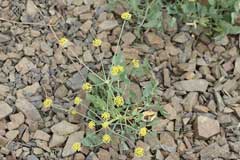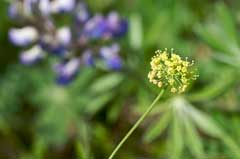 |
|
http://commons.wikimedia.org/wiki/User:Wsiegmund |
 |
| http://www.flickr.com/photos/foliosus/ |
Translate this page:
Summary
Physical Characteristics

 Lomatium nudicaule is a PERENNIAL growing to 0.6 m (2ft) by 0.6 m (2ft in).
Lomatium nudicaule is a PERENNIAL growing to 0.6 m (2ft) by 0.6 m (2ft in).
See above for USDA hardiness. It is hardy to UK zone 7. The species is hermaphrodite (has both male and female organs) and is pollinated by Insects. The plant is self-fertile.
Suitable for: light (sandy), medium (loamy) and heavy (clay) soils and prefers well-drained soil. Suitable pH: mildly acid, neutral and basic (mildly alkaline) soils. It cannot grow in the shade. It prefers dry or moist soil.
UK Hardiness Map
US Hardiness Map
Synonyms
Plant Habitats
Cultivated Beds;
Edible Uses
Edible Parts: Leaves Root Shoots Stem
Edible Uses: Tea
Root - raw or cooked[207]. The taste is rather like a hot spicy parsnip[207]. The root can be roasted and used as a vegetable, or can be dried and ground into a powder then used as a flavouring in soups etc[105, 161]. Leaves and young shoots - eaten as a vegetable or used as a celery-like flavouring in soups etc[177, 183, 257]. The leaves, stems and flowers are infused and used as a beverage[161, 183, 257]. Seed - raw or cooked[257]. The immature seed is chewed as a refreshing snack and can be used as a flavouring in soups etc[257]. The vitamin C content of young plants is remarkably high, one cup providing more than the recommended daily allowance[183]. (the part of the plant is not referred to, it is probably the leaves)
References More on Edible Uses
Medicinal Uses
Plants For A Future can not take any responsibility for any adverse effects from the use of plants. Always seek advice from a professional before using a plant medicinally.
Analgesic Diaphoretic Febrifuge Laxative Pectoral Poultice Vitamin C
The seeds are analgesic, diaphoretic, febrifuge, laxative and pectoral[257]. They have been chewed in the treatment of fevers, colds and sore throats[257]. An infusion has been used by pregnant women to ensure an easy delivery[257]. A poultice of the crushed seeds has been applied to the head to relieve the pain of headaches[257]. The poultice has also been applied to sore places, pains and itches[257].
References More on Medicinal Uses
The Bookshop: Edible Plant Books
Our Latest books on Perennial Plants For Food Forests and Permaculture Gardens in paperback or digital formats.

Edible Tropical Plants
Food Forest Plants for Hotter Conditions: 250+ Plants For Tropical Food Forests & Permaculture Gardens.
More

Edible Temperate Plants
Plants for Your Food Forest: 500 Plants for Temperate Food Forests & Permaculture Gardens.
More

More Books
PFAF have eight books available in paperback and digital formats. Browse the shop for more information.
Shop Now
Other Uses
Incense Repellent
The seed is spicy and aromatic, it is used as a house fumigant and deodorant. It also repels mosquitoes[99].
Special Uses
Food Forest
References More on Other Uses
Cultivation details
Requires a sunny position in a fertile well-drained soil[188]. Plants are frost hardy[188]. This is a taxonomically very difficult genus, many of the species now included in it have at times been included in other genera[60]. For polyculture design as well as the above-ground architecture (form - tree, shrub etc. and size shown above) information on the habit and root pattern is also useful and given here if available. The plant growth habit is a clumper with limited spread [1-2]. The root pattern is a tap root similar to a carrot going directly down [1-2].
References Carbon Farming Information and Carbon Sequestration Information
Temperature Converter
Type a value in the Celsius field to convert the value to Fahrenheit:
Fahrenheit:
The PFAF Bookshop
Plants For A Future have a number of books available in paperback and digital form. Book titles include Edible Plants, Edible Perennials, Edible Trees,Edible Shrubs, Woodland Gardening, and Temperate Food Forest Plants. Our new book is Food Forest Plants For Hotter Conditions (Tropical and Sub-Tropical).
Shop Now
Plant Propagation
Seed - best sown as soon as it is ripe in a cold frame[188]. Stored seed can be rather slow to germinate, when sown in the spring it usually takes at least 12 months to germinate. Giving it a period of cold stratification might reduce this time. The seedlings need to be pricked out into individual pots as soon as they are large enough to handle, and should be planted out into their permanent positions in the summer. Fresh seed can be sown immediately in situ[188]. Division may be possible in spring or autumn.
Other Names
If available other names are mentioned here
Native Range
NORTHERN AMERICA: Canada, British Columbia, United States, Idaho, Oregon, Washington, California, Nevada, Utah,
Weed Potential
Right plant wrong place. We are currently updating this section.
Please note that a plant may be invasive in one area but may not in your area so it's worth checking.
Conservation Status
IUCN Red List of Threatened Plants Status :

Growth: S = slow M = medium F = fast. Soil: L = light (sandy) M = medium H = heavy (clay). pH: A = acid N = neutral B = basic (alkaline). Shade: F = full shade S = semi-shade N = no shade. Moisture: D = dry M = Moist We = wet Wa = water.
Now available:
Food Forest Plants for Mediterranean Conditions
350+ Perennial Plants For Mediterranean and Drier Food Forests and Permaculture Gardens.
[Paperback and eBook]
This is the third in Plants For A Future's series of plant guides for food forests tailored to
specific climate zones. Following volumes on temperate and tropical ecosystems, this book focuses
on species suited to Mediterranean conditions—regions with hot, dry summers and cool, wet winters,
often facing the added challenge of climate change.
Read More
Expert comment
Author
(Pursh.)Coult.&Rose.
Botanical References
60
Links / References
For a list of references used on this page please go here
Readers comment
| Add a comment |
|
If you have important information about this plant that may help other users please add a comment or link below. Only comments or links that are felt to be directly relevant to a plant will be included. If you think a comment/link or information contained on this page is inaccurate or misleading we would welcome your feedback at [email protected]. If you have questions about a plant please use the Forum on this website as we do not have the resources to answer questions ourselves.
* Please note: the comments by website users are not necessarily those held by PFAF and may give misleading or inaccurate information.
To leave a comment please Register or login here All comments need to be approved so will not appear immediately.
|
Subject : Lomatium nudicaule
|
|
|
|